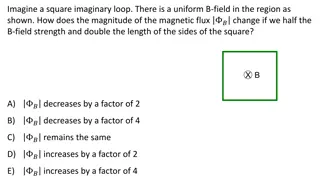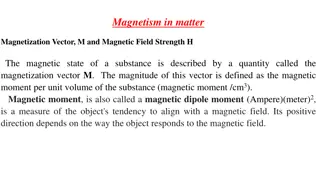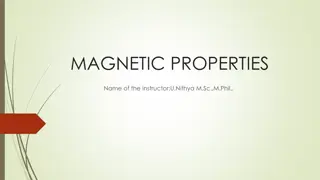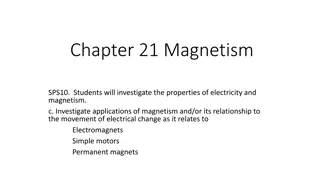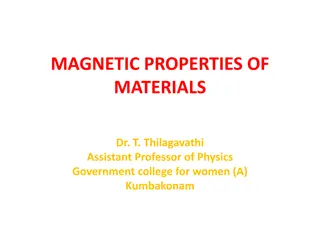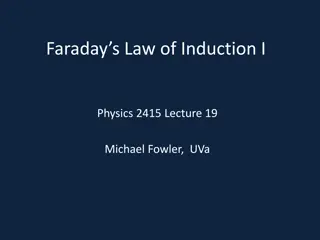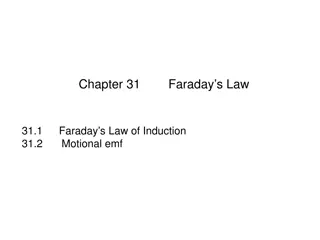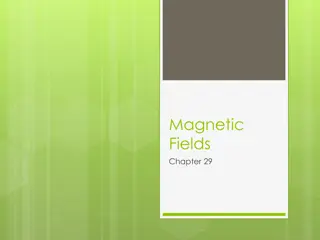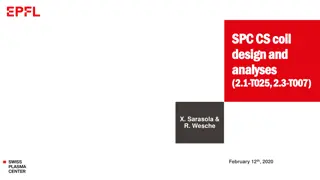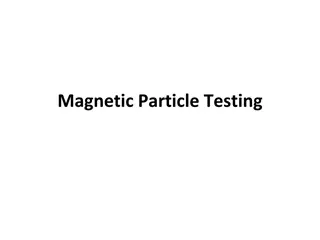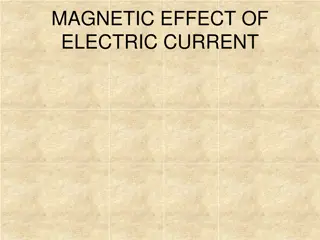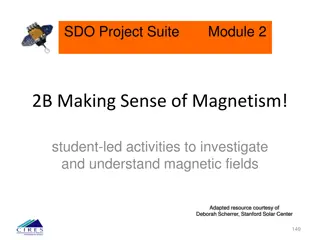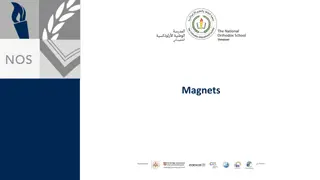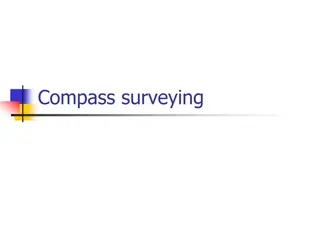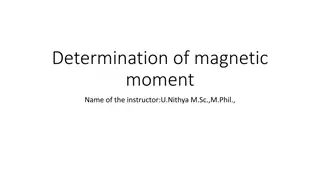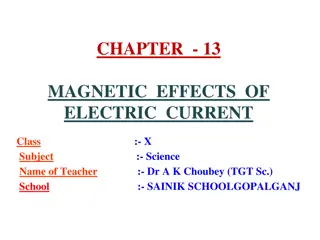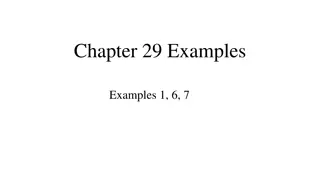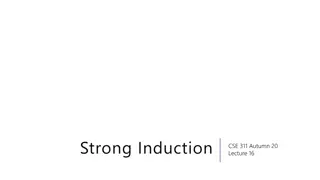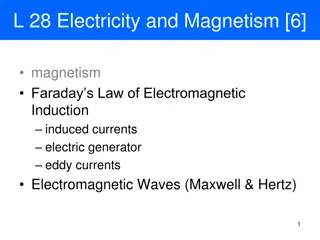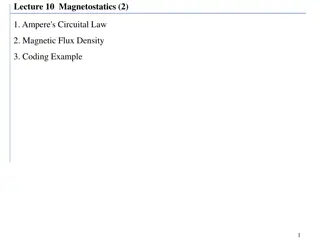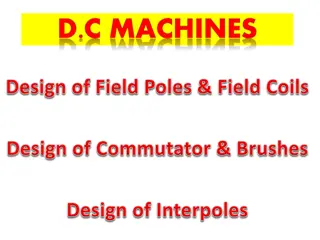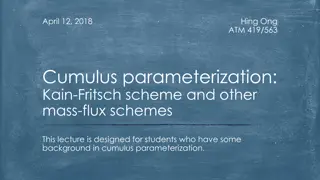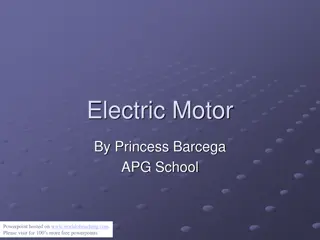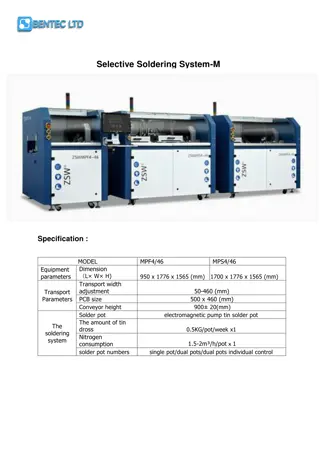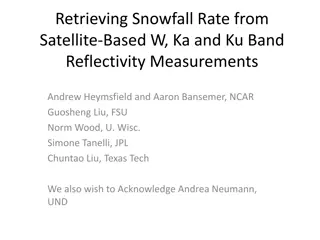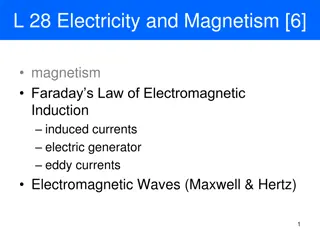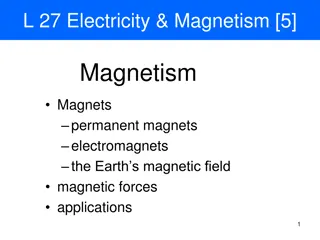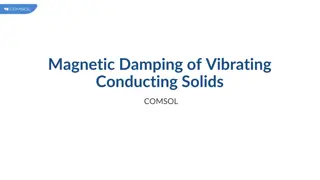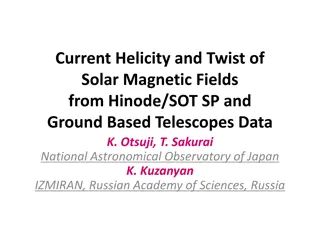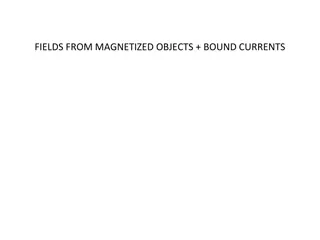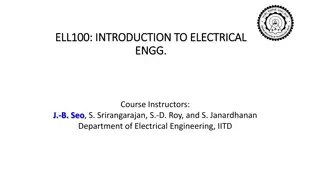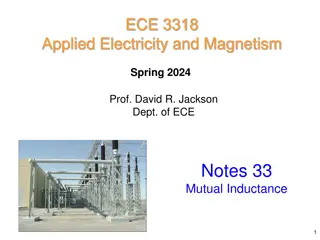Understanding Magnetic Flux and Induction Principles
Exploring the concepts of magnetic flux and electromagnetic induction through visual aids and explanations. Topics include the generation of current in coils, Faraday's law, Lentz's law, and the behavior of induced current with changing flux.
Download Presentation

Please find below an Image/Link to download the presentation.
The content on the website is provided AS IS for your information and personal use only. It may not be sold, licensed, or shared on other websites without obtaining consent from the author. Download presentation by click this link. If you encounter any issues during the download, it is possible that the publisher has removed the file from their server.
E N D
Presentation Transcript
Chapter 30 Induction
Few things to be remembered! From preceding chapters!
B Anticlockwise current N N I SS
clockwise current I S B N
Do you remember? Electric flux A E E . = E A
Similarly Magnetic flux A B E . = B A T83-28: In Dhahran, the total magnetic field of the Earth has been measured to be 0.54 x 10-4 T and it points downward at an angle of 530 below the horizontal. What is the magnetic flux through 1.0 m2 of ground in Dhahran due to the Earth magnetic field? A) 0.43 x 10-4 Wb
Magnetic filed B passes through the coil of area A S N . = B A Cupper coil Flux is constant: Coil and magnet are at rest Magnet
S N Cupper coil Flux Changing: If flux changes then the current gets generated in the coil Anyhow flux must change for the current This is principle of generating electricity
S N d dt d Faradays law: The rate of change of flux through a coil is equal to the emf generated in the coilc = = N dt Emf generated in the coil If the coil have N turns
S N Lentz s law: An induced current has a direction such that the magnetic field due to the current opposes the change in magnetic flux that induces the current. d = N dt Emf generated in the coil -ve sign is due to Lentz s law
S N Flux Increasing: More Field lines are passing through the coil. Coils induced current will generate a magnetic field that will try to oppose it. i.e. try to decrease the flux B Bi
S N Flux Decreasing: Less Field lines are passing through the coil. Coils induced current will generate a magnetic field that will try to oppose it. i.e. try to increase the flux B Bi
( . ) ( cos( )) d d B A d BA = = = N N N dt dt dt What will you do to create electricity?
T072: Q#28: A circular loop of radius R = 10 cm is placed so that its plane is perpendicular to a magnetic field that is increasing at a constant rate of 50 mT/s. What is the magnitude of the induced emf in the loop? (Ans: 1.6 mV)
Q14.: A long straight wire is in the plane of two circular conducting loops. The straight wire carries a constant current I in the direction shown in Fig 9. The circular loop 1 is moved to the right while the loop 2 is moved to the left with the same speed, v. The induced current directions in the circular loops 1 and 2 are respectively: (Ans: Clockwise , counterclockwise)
Q:The plane of a circular coil of radius 0.01 m is initially in yz plane and initially perpendicular to the uniform magnetic field 10 T i. The coil has 100 turns. Find the emf produced in the coil (in V) when the coil is flipped 30o about the y-axis passing through its center in 0.5 s .
Magnitude of Emf generated d = = = = d d d ( ( ) ) ( ) d BA BA d BLx = = dt dt dt dt dt dt dx dx = = = BL BL BLv dt dt iR = BLv BLv Opposing Force on the coil (F1) i = R F = 0 sin( 90 ) iLB BLv 2 2 2 B L v Power generated F = LB = = P Fv R R 2 2 B L v 2 2 2 B L v = F = = 2 P i R R R
( ) ( ) d d BA d BLx = = = = = iR N N N NBLv dt dt dt T72Q29. Consider a rectangular conducting loop of length a = 20 cm and width b = 10 cm and resistance R = 10 as shown in Fig. 1. The loop is moving out of a uniform magnetic field region, at a constant speed of 5.0 m/s. The magnetic field B is into the page and has a magnitude of 0.50 T. What is the magnitude and direction of the induced current? (Ans: 25 mA clockwise)
T111-Q30. A circular loop of wire of radius 14 cm is placed in the xy plane in a magnetic field that makes an angle of 30o with the normal to the plane of the loop, as shown in Figure 15. The magnitude of this field increases at constant rate from 30 mT to 60 mT in 15 ms. If the loop has a resistance of 5.0 , what is the current induced in the loop, looking from the top? A) 21 mA, clockwise
T103-Q30. Figure 9 shows a bar being moved to the right on two parallel rails at a constant speed of 3.0 m/s in a uniform magnetic field of 0.50 T directed into the page. If the induced current is 2.5 A, find the power dissipated in the resistor? (Neglect the mass of the bar, friction, and the resistance of the bar and rails). A) 4.5 W.
T81-Q15. A circuit is pulled to the right at constant speed in a uniform magnetic field with a 16 N force as shown in Fig 10. As the circuit moves, a 6.0 A current flows through the 4.0 resistor. With what speed does the circuit move? (Ans: 9.0 m/s)
T-041Q#1: A circular wire loop, of an area 0.10 m2, is initially oriented so that its plane is perpendicular to a 0.40 T magnetic field. When the loop is rotated so that its plane is parallel to the field, a 25 V average potential difference is induced across the loop. The time (in seconds) required to make this rotation of the loop is (Ans: 1.6x10-3).)
T81-Q16.: A 2.0 m long copper wire, with resistance 5.0 , is shaped into a square loop and placed perpendicular to a uniform magnetic field that is increasing at the constant rate of 1.0 10-2 T/s. At what rate is thermal energy generated in the loop? (Ans: 1.3 x10-6 W.)
T82 T61- Q#30. A constant magnetic flux of 4.0 10-5 Wb is maintained through a coil for 0.5 s. What emf is induced in the coil by this flux during that period? (Ans: Zero) A circular loop of radius R = 10 cm is placed so that its plane is perpendicular to a magnetic field that is increasing at a constant rate of 50 mT/s. What is the magnitude of the induced emf in the loop? (Ans: 1.6 mV)
T111-Q28 Figure 14 shows four wire loops, with edge lengths of either L or 2L. All four wires move toward a region of uniform magnetic field B (directed out the page) at the same constant velocity. As they enter the magnetic field, in which loop(s) is the greatest induced emf? A) 1 and 2 T111-Q29. A square loop of wire is held in a uniform 0.24 T magnetic field directed perpendicular to the plane of the loop. The length of each side of the loop is decreasing at a constant rate of 5.0 cm/s. What is the emf induced in the loop at the instant the length is 12 cm? A) 2.9 mV
T111-Q30. A circular loop of wire of radius 14 cm is placed in the xy plane in a magnetic field that makes an angle of 30o with the normal to the plane of the loop, as shown in Figure 15. The magnitude of this field increases at constant rate from 30 mT to 60 mT in 15 ms. If the loop has a resistance of 5.0 , what is the current induced in the loop, looking from the top? A) 21 mA, clockwise
T103-Q28. The normal to a certain plane with an area of 1.0-m2 makes an angle of 60 with a uniform magnetic field. The magnetic flux through this plane is the same as the flux through a second plane whose area is perpendicular to the magnetic field. The area of the second plane is: A) 0.50 m2 T103-Q29. A wire loop of radius 10 cm has resistance 2.0 . The plane of the loop is perpendicular to a uniform magnetic field that is increasing at a rate of 0.10 T/s. Find the magnitude of the induced current in the loop. A) 1.6 mA T103-Q30. Figure 9 shows a bar being moved to the right on two parallel rails at a constant speed of 3.0 m/s in a uniform magnetic field of 0.50 T directed into the page. If the induced current is 2.5 A, find the power dissipated in the resistor? (Neglect the mass of the bar, friction, and the resistance of the bar and rails). A) 4.5 W.
T102-Q28. A solenoid is designed to produce a magnetic field of 0.0250 T at its center. It has 1.20 cm radius and 30.0 cm length and the solenoid wire can carry a maximum current of 9.947 A. The total length of the wire required to make the solenoid is: A) 45.2 m T102-Q29. A 5-turn square coil (10 cm along a side, resistance = 4.0 ) is placed in a magnetic field that makes an angle of 30o with the plane of the coil. The magnitude of this field varies with time according to B = 0.50t2, where t is measured in s and B in T. What is the induced current in the coil at t = 4.0 s? A) 25 mA T102-Q30. A bar of length L = 80 cm moves with velocity V on two frictionless rails, as shown in Figure 9, in a region where the magnetic field is uniform (B = 0.30 T) and into the paper. If V = 50 cm/s and R = 60 m , what is the magnetic force on the moving bar?
T101-Q28. A conducting loop with an area of 12 cm2 and a resistance of 0.010 lies in the xy plane as shown in Figure 15. The loop is in a region of uniform magnetic field that is directed in the negative z direction. The magnitude of the magnetic field decreases from 0.80 to 0.50 T in 1.5 s. The current induced in the loop is A) 24 mA, clockwise T101-Q29. Figure 16 shows a bar of length L = 35 cm moving to the right on two parallel rails at a constant speed of 5.0 m/s in a uniform magnetic field B = 0.40 T. If the induced current in the circuit is 1.2 A, the power dissipated in the circuit is A) 0.84 W T101-Q30. A long straight wire carries a current i and is in the plane of a rectangular conducting loop, as shown in Figure 17. Which of the following will induce a clockwise current in the loop? A) Moving the loop to the right away from the wire, keeping the current in the wire constant
T92-Q28. Suppose this page is perpendicular to a uniform magnetic field and the magnetic flux through it is 5.0 Wb. If the page is turned by 30 around an edge the flux through it will be: A) 4.3 Wb T92-Q29. A circular wire loop of radius 15.0 cm is located in a uniform magnetic field that changes in magnitude as shown in Figure 12. The plane of the loop is perpendicular to the magnetic field. What is the magnitude of the emf induced in the loop during the time interval t = 0 to t = 2.00 s? A) 17.7 mV T92-Q30. A circuit, with side length L = 1.0 m, is pulled toward the right at a constant speed v = 3.0 m/s. At the instant shown in Figure 13, the loop is partially in a magnetic field of magnitude B = 5.0 mT that is directed into the page. As the circuit moves, an induced current flows through a resistor R = 5.0 . What are the magnitude and direction of the induced current? A) 3.0 mA, clockwise
T92-Q29. A circular coil of wire has 25 turns and has a radius of 0.075 m. The coil is located in a variable magnetic field whose behavior is shown on the graph of Figure 13. At all times, the magnetic field is directed perpendicular to the plane of a loop. What is the magnitude of the emf induced in the coil in the time interval from t = 5.0 s to 7.5 s? A) 71 mV T92-Q30. Two conducting loops carry equal currents I in the same direction as shown in Figure 14. If the current in the upper loop drops to zero, what will happen to the current in the lower loop? A) The current will increase. B) The current will not change. C) The current will drop to zero. D) The current will reverse its direction. E) The current will decrease
T83-28: In Dhahran, the total magnetic field of the Earth has been measured to be 0.54 x 10-4 T and it points downward at an angle of 530 below the horizontal. What is the magnetic flux through 1.0 m2 of ground in Dhahran due to the Earth magnetic field? A) 0.43 x 10-4 Wb T83-Q29. A rod (length L=10 cm) moves on two horizontal frictionless conducting rails , as shown in Fig. 10. The magnetic field in the region is directed perpendicular to the plane of the rails and is uniform and constant. If a constant force of 0.60 N moves the bar at a constant velocity of 2.0 m/s, what is the current through the 12 ohm resistor? A) 0.32 A T83-Q30. A circular loop of radius 45 cm is moved with a speed of 10 m/s inside a region containing a constant magnetic field of magnitude 0.50 T. If the direction of the magnetic field is perpendicular to plane of the circular loop, what is the magnitude of the induced emf in the circular loop? A) Zero
Q29. In the Fig. 2 the magnetic field decreases from 1.0 T to 0.40 T in 1.2 s. A 3.0 cm radius conducting loop with a resistance of 0.010 is perpendicular to B. What are the size and the direction of the current induced in the loop? (Ans: 140 mA and current is clockwise.) Q#8. A flat circular coil has 80 turns of diameter 20 cm with a total resistance of 40 . The plane of the coil is perpendicular to a uniform magnetic field. At what rate should the magnetic field change for the power dissipated in the coil to be 2 W? (Ans: 3.6 T/s)



